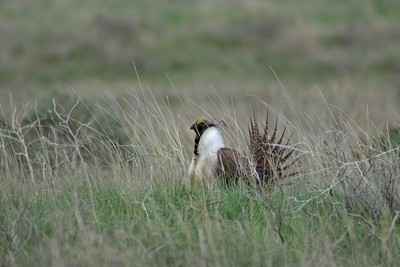 Every spring anxious eyes turn towards the sage-grouse mating grounds (known as “leks”) of southern Alberta to see whether or not Canada’s sage-grouse made it through the winter. This year’s spring population counts observed only 13 males at Alberta leks, showing no improvement since last year. In Saskatchewan, the only other Canadian province in which sage-grouse persist, huge population declines were observed. Only 18 males were counted at Saskatchewan leks, a dramatic decrease from the 42 males last recorded.
Every spring anxious eyes turn towards the sage-grouse mating grounds (known as “leks”) of southern Alberta to see whether or not Canada’s sage-grouse made it through the winter. This year’s spring population counts observed only 13 males at Alberta leks, showing no improvement since last year. In Saskatchewan, the only other Canadian province in which sage-grouse persist, huge population declines were observed. Only 18 males were counted at Saskatchewan leks, a dramatic decrease from the 42 males last recorded.
Sage-grouse scientists suggest that these lek counts, a total of 31 observed males in Canada, indicate a total population of approximately 62-93 birds.
“Less than one hundred birds now stand between sage-grouse being endangered, and sage-grouse being extinct in Canada,” says AWA conservation specialist Madeline Wilson. “Although it is disappointing to see no improvement from last year in Alberta, it’s not very surprising given the lack of on-the-ground action from either provincial or federal governments to protect sage-grouse habitat.”
The cause of this relentless decline is no mystery; sage-grouse are highly sensitive to habitat disturbance. Research has shown that when confronted with oil and gas development, sage-grouse abandon their leks and other habitats crucial to their survival. As sage-grouse range continues to disappear in Canada, it is extremely troubling to see such significant declines in Saskatchewan.
Although sage-grouse has been listed as Endangered provincially since 2000 and federally since 1998, both levels of government have failed to take any effective action to halt this steep decline. Total Canadian populations have decreased by nearly 90% between 1988 and 2006.
In the last two years, the Alberta government has launched a translocation program using birds from Montana. But considering the main cause of species decline is habitat fragmentation and degradation primarily due to rampant oil and gas activity, population supplementation will not prevent sage-grouse extirpation. At best they are prolonging the inevitable; at worst they are delivering Montana birds to their death.
“The provincial government insists on treating the symptoms, rather than the source of the problem. When habitat loss is the well-known cause of species decline, transporting more birds into the province without first ensuring remaining sage-grouse habitat is protected seems incredibly counter-productive.”
Madeline Wilson, Alberta Wilderness Association


